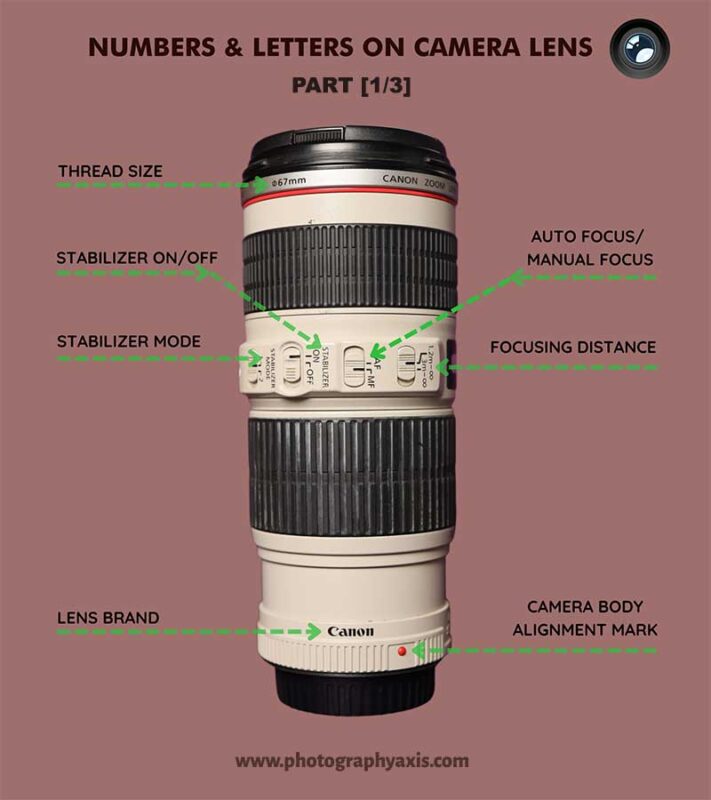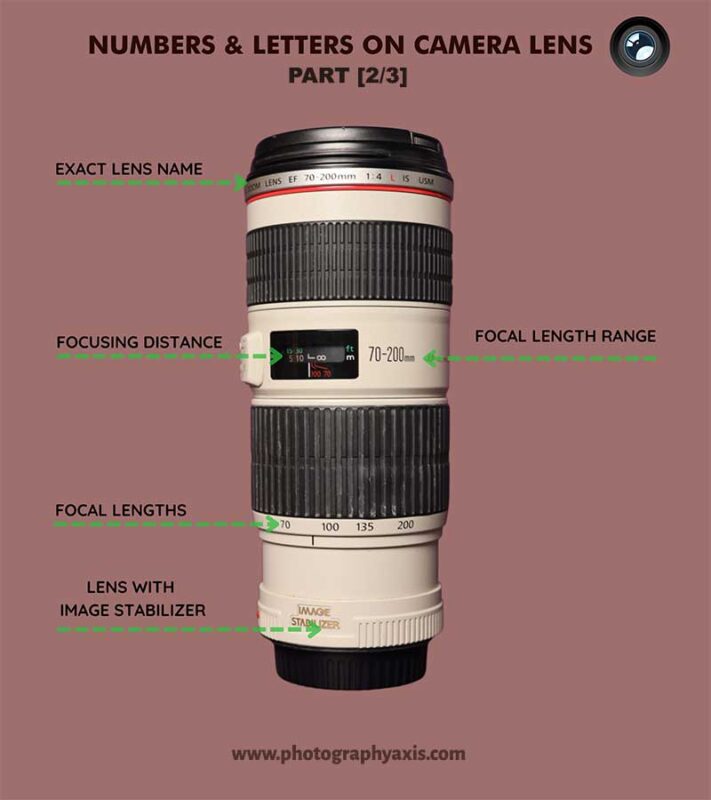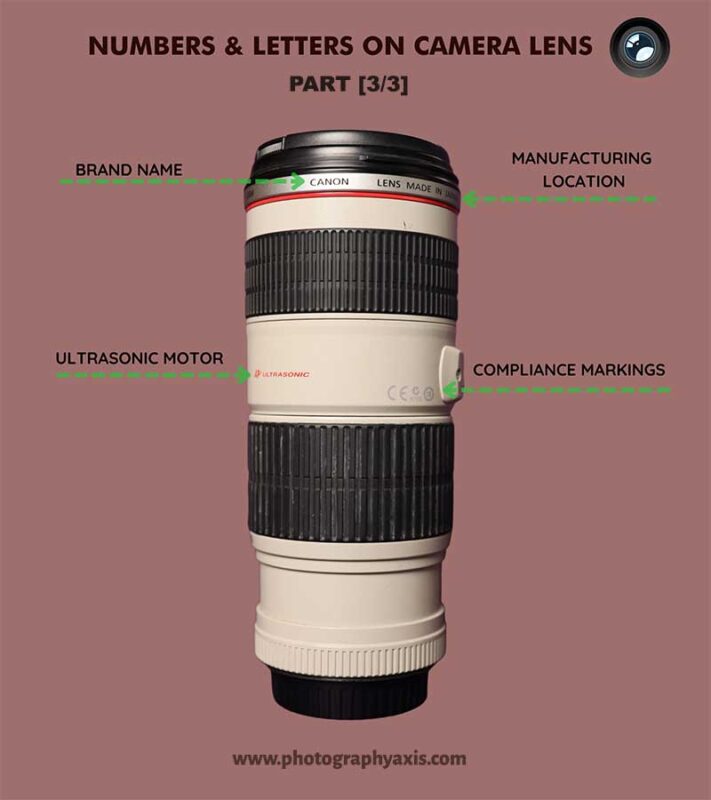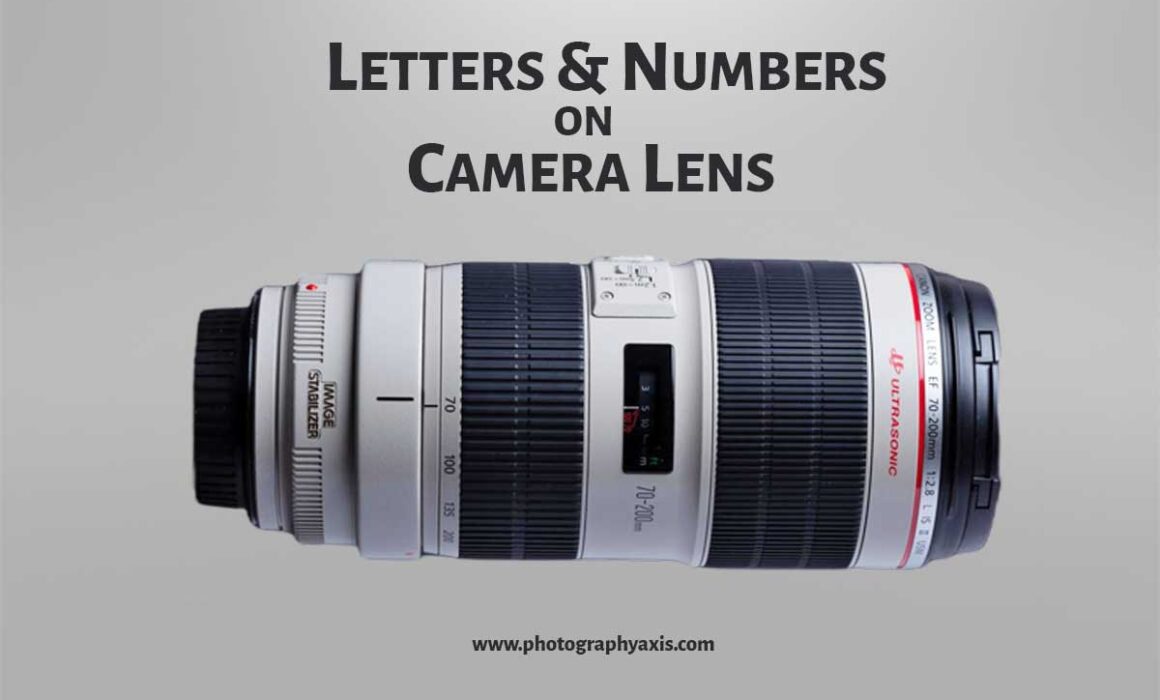Meaning of Numbers & Letters on Camera Lenses Explained
When you get a lens for your camera body for the first time, you can see different letters and numbers on it. What do these numbers and letters on lenses mean?
I will explain the meaning of all these parameters in detail through this guide.
These numbers and letters remain more or less the same for all types of camera lenses from different manufacturers.
What Do the Numbers and Letters on Lenses Mean?
The numbers and letters on a camera lens show the different specifications of the lens. I will share all these specifications below.

1. Thread Size
The thread size of the lens will be shown along with the Phi symbol (Φ). It will be a number.
If you want to attach any filters to the lens, you need to know the thread size. The filter thread size must match the camera lens thread size.
2. Image Stabilizer/ Vibration Reduction (ON/ OFF)
If the lens you have has an inbuilt image stabilization option, you can see the stabilizer ON/OFF switch in it.
Different camera brands use different brand names for image stabilization.
Canon uses an Image stabilizer (IS).
Nikon uses Vibration Reduction (VR).
Sony uses Optical Stabilization (OS).
You can toggle this switch to ON and OFF the stabilization feature of the lens.
3. Stabilizer Mode (1,2,3)
High-end lenses, especially telephoto lenses, come with different stabilizer modes also. It can be two modes or 3 modes.
If there are 3 modes, you can see a slider switch that can be moved in 3 positions.
Mode 1 is the standard one. You can set it for all shots captured handheld. Here, the gyro inside the lens can help fix some camera shake.
Mode 2 is for panning shots. When you pan and photograph a subject, you don’t want the stabilizer to consider the horizontal camera movement. Here, the gyro in the lens will only try to fix the vertical/ perpendicular camera movement.
Mode 3 is useful for sports and wildlife photography. Here the image stabilization is activated only when you fully press the shutter trigger button.
4. Focusing (AF/MF)
All camera lenses that support autofocusing will come with the AF/MF switch.
Here, AF stands for Auto Focus, and MF stands for Manual Focus.
You can slide the switch to AF if you want to use the autofocusing feature. If you want to focus on the subject manually, slide this button to MF.
5. Focus Distance
Some camera lenses, especially telephoto lenses, will also come with a switch to change the focus distance range.
The advantage of using this switch is to get a fast-autofocusing speed for a short range.
When you go with the full focus range, there will be a small reduction in focusing speed.
6. Lens Brand Name
The camera brand name will be printed on all camera lenses.
You can see Canon, Nikon, Sony, Tamron, Laowa, Sigma, etc., written on the lens manufactured by these brands.
The brand name will also be there on the front and rear lens caps.
7. Camera Body Alignment Mark
The lens will also come with an alignment mark on the rear side.
You need to align this mark with the mark in the camera body and attach it.
Afterward, turn the lens in a clockwise or anticlockwise direction to connect the lens to the camera body. The direction of rotation will be different for different camera brands.

8. Exact Camera Lens Name
The exact camera lens name will also be printed on the camera lens.
It tells you different lens specifications. It includes lens brand name, Focusing motor type, focal length range, image stabilization, and maximum aperture.
9. Focusing Distance Display
Many lenses, especially high-end lenses, also have a focusing distance display.
You can see the values in this display changing when you rotate the focus ring in the lens or when you use the autofocus in the camera to focus on a subject.
10. Focal Length Range
You can also see the focal length range of the lens written on the lens in mm.
There will be a single focal length if it is a prime lens. For zoom lenses, you can view the focal length range on the lens.

11. Manufacturing Location
Most camera lenses will also have the manufacturing country name printed on them.
If you use a Nikon or a Canon lens, you can see “MADE IN JAPAN” written on it. It tells you where your camera lens is manufactured.
12. Focus Motor Type
You can also see the type of focusing motor printed on the camera lens.
If it is a Canon lens, it will be STM or USM motor.
If it is a Nikon lens, it will be AF-S, AF-P, AF-I, and AF motor.
13. CE Marking & Other Details
You can also see the “CE” mark and other compliance details on the camera lens.
It shows the compliance specifications of the lens. It has nothing to do with the functional specification of the lens.
14. Lens Part Number
All camera lenses will come with a part number. This part number will be specific to that specific lens. Also, no two lenses will have the same part number.
This lens part number will usually be printed on the rear side of the camera lens. You can see it once you remove the back cap of the lens.
15. Focus Preset
The focus preset feature will be there in high-end prime telephoto lenses.
There will be two buttons here. The first button is to enable the focus preset. It will be denoted by the “SET” button in Canon lenses.
The second button will be a slider that has 3 positions – ON. OFF, and beep sound indicator.
If you want to use the focus preset, you need to put the slider to ON or beep sound indicator.
Final Thoughts
Now you know the exact meaning of different numbers and letters in a camera lens.
It is essential to have a basic understanding of these parameters. It will help you to use your camera gear efficiently.

